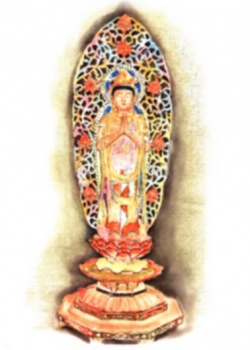Ambrosia Gate
Ambrosia Gate (Kanromon 甘露門)
Literally, the "approach" or "method" (mon 門) of [giving] "sweet" (kan 甘) "aromatic beverage" (ro 露). A sequence of verses and dharanis used to ritually feed hungry ghosts (segaki 施餓鬼) and unconnected spirits (muenboke 無縁佛). Although this may be considered a Tantric rite that has its roots in the Shingon (C. Zhenyan 眞言) tradition of Tang dynasty China, the text entitled Ambrosia Gate used in Japanese Zen today derives from Tendai (C. Tiantai 天台) ritual manuals that circulated widely in the Buddhist monasteries of Song dynasty China. The Sino-Japanese term kanro has often been mistranslated as "sweet dew." Ro can mean "dew" in some contexts, but in this case it refers to an aromatic decoction distilled from flowers, fruit, or herbs. Kanro entered the Chinese Buddhist lexicon as a translation of the Sanskrit amta or "nectar of immortality," understood in ancient India as the drink of the devas (gods). In Indian Buddhism, the dharma was likened to amta because it frees those who imbibe it from suffering in the round of rebirth. In China, hungry ghosts are called "burning mouths" because, it is believed, their bad karma causes whatever food comes their way to burst into flames before they can consume it. The ritual offering of ambrosia douses those flames and enables them to receive the same "offerings of nourishment" (kuyō 供養) - food, drink, and merit - that are given to ancestral spirits who have descendants to care for them. "gate," "Bon festival," "hungry ghosts," "decoction."
Source
global.sotozen-net.or.jp [[Category:]]
